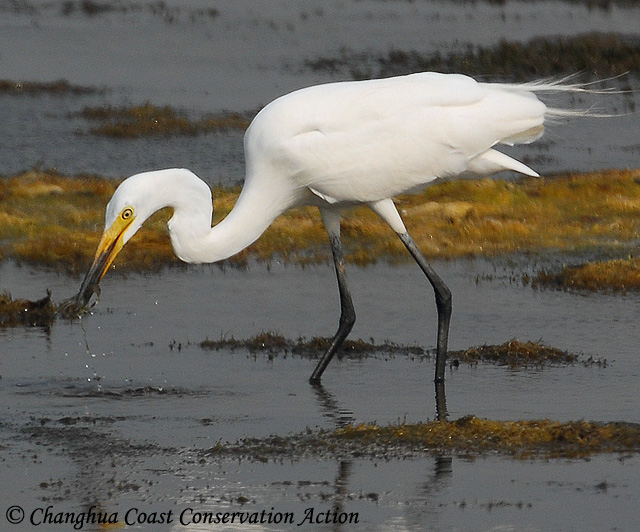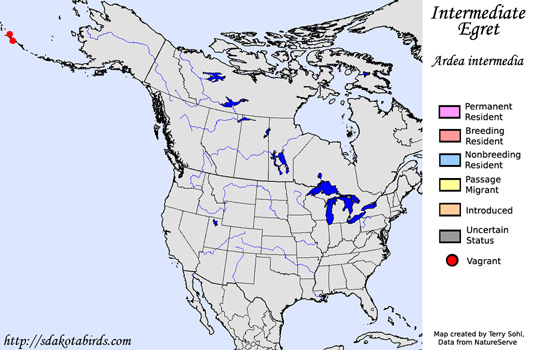| Length: 23-27 inches | Wingspan: 42-46 inches | Seasonality: Non-resident in South Dakota |
| ID Keys: White plumage, yellow bill with dark tip, black legs and feet, long plumes on back when in breeding plumage | ||
 The
Intermediate Egret is an Old World species that is so named because it is
intermediate in size between the Great Egret
and the Little Egret. They are
normally found in Africa south of the Sahara, across southern Asia to Japan,
and southward into Australia. In North America, they are but extremely rare
vagrants, with a handful of sightings in the far outer Aleutian Islands.
The
Intermediate Egret is an Old World species that is so named because it is
intermediate in size between the Great Egret
and the Little Egret. They are
normally found in Africa south of the Sahara, across southern Asia to Japan,
and southward into Australia. In North America, they are but extremely rare
vagrants, with a handful of sightings in the far outer Aleutian Islands.
Habitat: Found in both freshwater and saltwater habitats, including estuaries, freshwater wetlands and marshes, shorelines of rivers and lakes, and flooded rice fields. Usually found in areas with thick wetland vegetation.
Diet: Feeds on fish, amphibians, crustaceans, mollusks, large insects, and other aquatic creatures.
Behavior: Often forages by standing motionless in the water, quickly thrusting its neck and bill out to capture prey when prey approaches. They may also stalk prey by moving slowly through the shallows.
Nesting: Colonial nester, sometimes nesting in large colonies with other wading bird species. The nest is a loos platform built of sticks and wetland vegetation, placed in trees, shrubs, or reedy areas near water. The female lays 2 to 4 eggs, and both parents help to incubate them. After hatching, both parents help feed and tend to the young. The young leave the nest after about 5 weeks.
Song: Usually silent, but they do have a guttural croaking sound sometimes given while taking flight. They also can make some buzzy chatters during courtship displays.
Migration: Some populations that breed at the northern end of their range are migratory, such as those birds nesting in Japan. However, the majority of Intermediate Egrets are non-migratory.
Interactive eBird Map: Click here to access an interactive eBird map of Intermediate Egret sightings
Similar Species: Similar in appearance to North America's white egret species, including the Great Egret and Snowy Egret. Also similar to Old World Little Egret.
Conservation Status: Populations may be in decline, but they are still found over a wide geographic region and are relatively common in some areas. The IUCN lists the Intermediate Egret as a species of "Least Concern".
Further Information: 1) BirdLife International - Intermediate Egret
2) Oiseaux-birds.com - Intermediate Egret
3) BirdLife Australia - Intermediate Egret
Photo Information: Photo by Changhua Coast Conservation Action - Photo licensed under Creative Commons Attribution NonCommercial NoDerivs 2.0 Generic License.
| Click below for a higher-resolution map |
 |
| South Dakota Status: Non-resident in South Dakota |
Additional Intermediate Egret Photos (coming soon!!)
